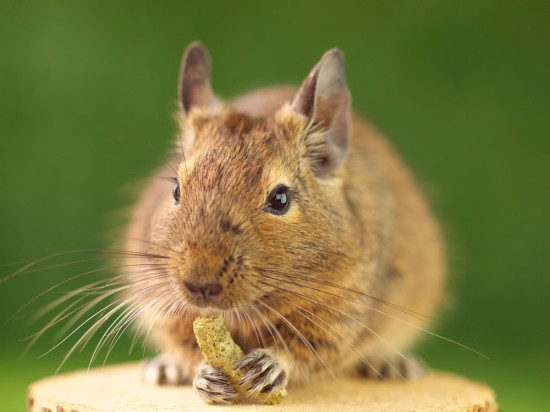

The Degu is a small rodent that is native to Chile. Similar to Chinchilla’s and Guinea Pigs, Degu’s, also known as the brush tailed rat, make marvellous pets if you can get over the fact that in the wild they are extremely sociable. In fact there are usually so many living together that they excavate their burrows by forming chain gangs! Obviously I ‘m not suggesting that you keep that many Degu’s but you should choose to keep more than one as isolation will not suit their highly sociable personality.
When choosing your Degu’s residence choose carefully. A glass or metal cage is preferable to a plastic one as Degu’s are notorious chewers. A metal cage with multiple levels like a rat’s cage is ideal.
Make sure your pets have regular access to Chinchilla sand as Degu’s need sand baths to keep their coats healthy. Two or three times a week is ideal as constant sand bathing can soil the fur.
Grooming can form part of their care and your attention will be reciprocated by a tame Degu as he gently nibbles you.
Degu’s are easily tamed and will easily bond with you if you spend time with them but a word of warning - whilst grooming or playing with your Degu’s never hold or grab them by the tail as it will fall off and unlike a lizard your Degu’s tail will not grow back.
Strictly herbivorous, in the wild Degu’s feed on grass, leaves and seeds and can tolerate a very high fibre intake. However, because of problems ingesting sugar great care should be taken to feed your pet Degu’s the correct diet. You need to look carefully at the content of any food that is not proprietary as it may contain sugar beet, molasses or other sweet things. Also, similarly to Guinea Pigs, Degu’s cannot synthesise their own vitamin C so you will need to add drops to their water.
In addition your Degu’s will also require plenty of hay and some fresh fruit and vegetables. Apples and carrots can be favourite treats and your Degu’s will come readily to greet you when presented with these.
When I had my first Degu’s I thought they were the same sex but one morning I went to feed and clean their residence only to take the lid off the nest box to find what appeared to be a heap of tiny pancakes! They were, in fact, ten sweet little Degu babies! As I had read that the male Degu helps the female to look after the pups I left them all together. Degu’s are very vociferous and make lovely little whistling sounds whilst the males also making a continuous crowing noise after mating and so I was shocked to approach the cage one morning only to find the father of the current litter of pups on top of the nest box crowing about his success! And yes he was successful because the next thing I knew I had even more baby Degu’s!
Due to this it is important to be able to tell the sexes apart and separate males from females although there should still ideally be more than one Degu in a cage. Unfortunately male Degu’s may fight for top position and if this happens you could separate them into different cages but put the cages side by side so that the Degu still has company but at a safe distance!
Females of this sociable species will nurse the young of others as well as their own pups whilst, unusually for a rodent and as I said previously, the males will take responsibility for the care and protection of their young. In the nest the babies will all lie facing in the same direction and when the adult Degu’s join them they huddle round the babies but instinctively face in different directions in order to see predators approach and protect their young.
Degu’s pups have a long gestation period of three months and a litter can comprise of anything between one and twelve with the average being six. The pups are born ready to go, so to speak, fully furred and with eyes open - an inbuilt protection device.
The species was first captured in order to assist scientists in their research. Degu’s cannot tolerate free sugars in their diet as this can lead to them developing diabetes so these creatures and their unique relationship to sugar and diabetes have played a big role in the treatment of the disorder.
Also scientists looking for an animal with good eye and paw coordination chose to use Degu’s in their research into animals and their use of tools. Degu’s are intelligent creatures making them an excellent species to study; they have even been found to spontaneously stack objects in order of decreasing size. Another quality which is of great interest is the Degu’s ability to use his brain to tell the time of day and they have also been helpful in the study of development and aging as they display separation anxiety and ADHD symptoms. In fact the pups are dependant on hearing the calls of their mother in order to develop emotionally.
Another type of research for which they are useful is that of Alzheimer’s disease as elderly Degu’s have been found to have neural markers similar to those found in humans with the condition.
Because they are active in the daytime, Degu’s make a more interesting pet than other rodents which are often only active at night. They also have a very bubbly personality and their tail is covered in hair which, for some people, is preferable to the bald tails of rats and mice. In addition Degu’s have a long lifespan of up to thirteen years although in captivity this is reduced to between six and eight years.
So enjoy your Degu’s and remember to always keep more than one.
Copyright © 2005-2016 Pet Information All Rights Reserved
Contact us: www162date@outlook.com